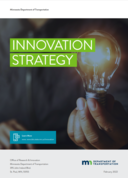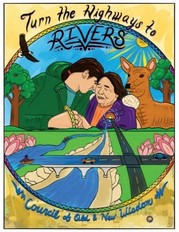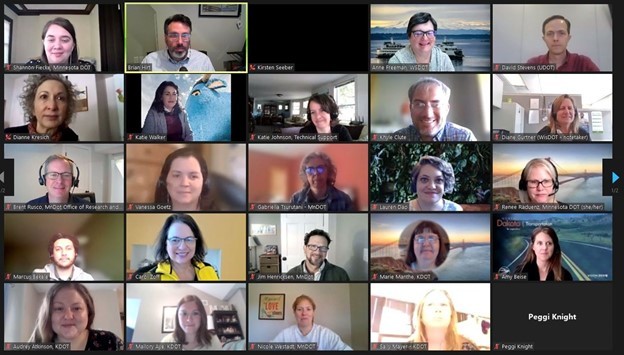MnDOT Innovation Focus


By Katie Walker, MnDOT's Research & Innovation Director
We're excited to announce the release of MnDOT's innovation strategy!
In a world of rapidly changing needs, government must operate effectively and efficiently to deliver today’s services and plan for tomorrow. Government leaders are increasingly seeing innovation as a mindset and process to help solve challenging problems and improve the lives of the people they serve.
|

In 2020, MnDOT began the deliberative process of developing an innovation strategy to help the agency solve its greatest challenges and more effectively and efficiently deliver transportation services.
The strategy outlined in this new report provides an actionable roadmap for fostering and maintaining a culture of innovation. This will lead to novel and sustainable products, processes, and practices that further MnDOT’s reputation as a national transportation leader.
|
MnDOT’s Innovation Technical Advisory Panel (TAP) is forming four virtual short-term working groups this spring to explore how to implement the new Innovation Strategy in four key areas: Communications, Reward & Recognition, Idea Pipeline & Portfolio, and Training & Development. Working groups will develop ideas, sort priorities, evaluate impacts, and generate recommendations. Stay tuned for report outs in our next newsletter! |
|
 |

In 2019, behavioral artist Marcus Young 楊墨 joined MnDOT as the agency’s first ever artist-in-residence.
In collaboration with Smart Growth America, the two-year fellow was tasked with creatively meeting the agency’s goals of promoting economic vitality, improving safety, supporting multimodal transportation systems, and creating healthier and more equitable communities.
He began his residency completing rotations throughout work areas across MnDOT. Marcus then started facilitating conversations about the relationships at MnDOT with the land, the public, and between staff members.
With his fellowship coming to a close, we’d like to celebrate three innovative projects Marcus led to encourage creativity and uplift community voices at MnDOT:
-
Land Acknowledgement Confluence Room: Marcus repurposed a conference room at MnDOT’s Central Office where staff will be able to gather, be creative, and explore new everyday cultural practices of land acknowledgement.
-
Turn the Highways to Rivers, Councils of Old & New Wisdom (PDF): Marcus used the art of storytelling and listening to advance MnDOT’s Statewide Multimodal Transportation Plan (SMTP). Marcus convened the “Council of Old and New Wisdom,” including community members and MnDOT staff to ask questions, share stories, and read poems related to transportation and the freedom of movement. The conversations resulted in “Turn the Highways to Rivers,” an art appendix, that will serve as a reference for future innovation in statewide transportation planning.
-
Interdisciplinary Conversations: This May, Marcus is hosting two half-day cohorts exploring what it means for MnDOT to be a people-centered organization—focused on brining equitable, people-centered future of transportation in Minnesota.
For a complete list of Young’s projects, visit the MnDOT website.
MnDOT’s new artist-in-residence, Sarah Petersen is just getting started! Peterson is an artist, educator, and organizer who will experiment with artistic projects, tools, and strategies to reduce transportation carbon pollution in Minnesota and beyond. Stay tuned!
|

Over the years, dozers have been the desired tool for pushing snow drifts back along highways. While dozers work well, they are limited by the drivability between drift locations.
What about utilizing MnDOT's John Deere tractors, normally used for summer mowing? Swapping wheels for tracks and adding dozer blades could transform this equipment into multifunctional year-round machinery.
District 8 and District 4 are currently pilot testing two brands (Mattracks and Soucy) of tracks through the Maintenance Operations Research program.
Both districts are evaluating field performance, cost savings, quality improvement, and safety improvement over an 18-month period.
If successful, these tractor plows will have a variety of perks compared to traditional dozers. They are less expensive and consume less fuel. They are lighter, allowing them to float over the snow and push drifts away from the roadway. And they can be driven down the road to the next location without loading or unloading.
|

For many years, MnDOT staff have interacted with unsheltered populations, typically when individuals are encamped on or near rights-of-way.
MnDOT has been working to approach these encounters with awareness, resilience, and safety. Recently, the agency earned national recognition for these efforts through its selection as a 2022 Innovation Initiative by the American Association of State Highway and Transportation Officials (AASHTO)
MnDOT’s innovations in this area include:
-
Mobile Mapping & Camp Data Entry: An app-based solution that allows MnDOT staff to enter encampment location information and activity details while in the field and analyze camp size and cleanup costs over time.
-
Encampment Procedures Guide: A guide detailing when and how encampment removal and clean-up should occur and how staff should operate in and around encampments.
-
Training for Field Staff: A seven module video series to help field staff them navigate the complexities of encountering unsheltered individuals.
AASHTO’s Innovation Initiative seeks out proven advancements in transportation technology to accelerate their adoption nationwide.
Each year, the program selects highly valuable technologies, processes, software, or other innovations that have been successfully adopted by at least one agency and offer significant benefit to other agencies.
Ready-to-use technologies from other DOTs recognized this year include Steel Press-Brake-Formed Tub Girder, On-Demand Microtransit, and Beam End Repair Using Ultra-High Performance Concrete.
|
 MnDOT held a Peer Exchange to learn from other states that have also started innovation programs and share best practices on topics of interest to our state research program, including how to quantify the value of research and encourage equity-focused research.
What We Learned From DOTs Across the US
-
California: In 2020, Caltrans hosted their first biannual Innovation Expo, highlighting creative employees and innovative projects that improve products and processes. Caltrans also launched a web-based innovation crowdsourcing tool to elicit ideas from employees statewide.
-
Utah: Utah created an innovation program dashboard that tracks the cost savings from DOT innovation and produced a fun animated video to show the public how Utah research is making a difference.
-
Washington: Washington utilizes a three-pronged funding approach: traditional research, innovation-focused projects, and rapid response research (4-6 week rollout). The latter allows them to quickly fund projects that cost less than $50,000 without a long review process.
This newsletter is produced by MnDOT's Office of Research & Innovation. Have a story idea? Let us know! If you have a question or need content in an alternative format, please contact our office at research.dot@state.mn.us or 651-366-3738.
|